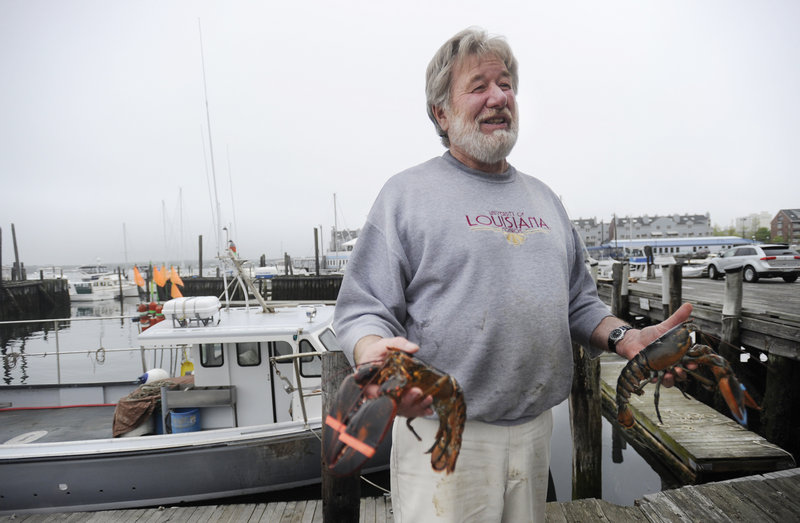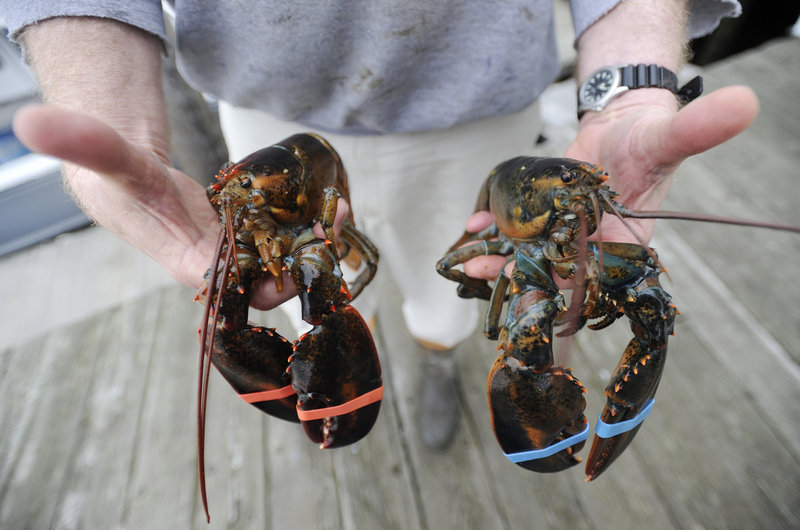CAPE ELIZABETH — Lincoln Jordan pulled a rectangular wire basket from a display tank inside his family’s vegetable stand at Alewive’s Brook Farm on Wednesday morning.
“It usually looks like this,” he said, as half a dozen soft-shell lobsters glistened orange and brownish-black in the bottom of the dripping basket.
“But this morning, these were filled to the top,” he said, gesturing toward a row of five similar baskets. “I’ve never seen this many culls this time of year for soft shell.”
Steve Train, a lobsterman on Long Island, returned to hauling traps last week after taking a month off while he switched boats.
“We’re definitely seeing more than I usually see this time of year,” he said of the soft-shell lobsters, also called shedders, which normally don’t start showing up in abundance until June or early July. “You don’t expect to get those shedders (in May).”
Local retailers started splitting prices — lower for soft shells and higher for hard shells — in late April and early May.
“Nobody’s ever seen the prices split so early,” said Jody Jordan, Lincoln’s father, standing behind bins of turnips, potatoes and parsnips at Wednesday’s farmers market in Portland’s Monument Square. “Usually, there’s just one price until the middle of June.”
The elder Jordan, who will turn 61 in October, started fishing for lobsters when he was 12. He said the lobsters he catches near the shore are generally hard-shelled, because the shallower water turns colder in winter, even one as mild as the one Maine just experienced.
“But offshore, in 200 or 300 feet of water, the catch is almost 90 percent soft-shell lobsters when it should be the other way around this time of year,” he said.
Data on landings for 2012 isn’t yet available, said Carl Wilson, lead lobster biologist for the state Department of Marine Resources. Still, a look at recent years reveals that the spring lobster season is dwarfed by that of the summer and early fall.
The total catch in March, April and May was 4.12 percent of the 2009 total, 4.21 of the 2010 total and 3.66 of the 2011 total, which surpassed 100 million pounds for the first time.
“So I don’t think we’re talking about a huge volume at this point,” Wilson said. “Even if it is a strange spring, it doesn’t predict what’s going to happen for the total landings of the year.”
Nick Alfiero, proprietor of Portland’s Harbor Fish Market, said the appearance of soft shells this early is unusual, but has little impact on his business.
“If we were flooded and the lobsters were jumping out of the tanks and we were up there at $3.99 (a pound) trying to get rid of them, it would be a story,” he said. “But they’re coming in small quantities.”
Per-pound prices at Harbor Fish Market on Wednesday were $6.99 for soft shells, $8.99 for smaller hard shells and $10.99 for medium-sized hard shells. Only the hard-shell lobsters can survive the rigors of shipping, so soft shells are strictly a local delicacy.
Steve DiMillo Sr. of DiMillo’s On the Water restaurant buys only hard shells because “we want to ensure there’s plenty of meat in the lobsters,” he said.
Although the soft-shell lobsters contain more water and less meat, most of the lobstermen and retailers interviewed Wednesday said the meat tastes sweeter and is more tender.
And chefs like David Turin of David’s Restaurant in Portland and Chris Barrett of the Azure Cafe in Freeport said picking the cooked meat for use in ravioli, lobster rolls or other dishes is much easier with soft shells.
“It’s nice to not shred your hands on the super-hard ones when you’re shucking them,” said Turin.
“It takes a lot of work to crack lobsters,” Barrett said. “The easier they are to crack, the less time we have to spend doing it.”
Ditto for local processing plants such as Cozy Harbor Seafood.
“They do most of the hand-picked meat for the area,” Barrett said.
As for theories, water temperature clearly plays a role in a lobster’s movement and metabolism. When ocean temperatures drop below, say, 40 degrees, Wilson said, lobsters are less likely to eat.
By actively feeding throughout this winter, lobsters molted in spring instead of summer and grew larger — the carapace increases by 10 percent to 15 percent with each molt, he said.
Pete McAleney of New Meadows Lobster considers ocean currents and the lack of severe winter storms from the north and east the reason for the warmer water temperatures.
“If you look at my house,” said McAleney, pointing out his second-story abode on the end of Portland Pier, “all the paint is chipped on (the western) side because the storms all came this way. Usually, we have to paint the front of this building, but nothing happened. It was a crazy winter.”
McAleney also said the abundance of shedders is restricted to certain areas in the Gulf of Maine. Few have been caught Down East, for example, or in parts of Casco Bay.
“But down around Five Islands,” he said, “that’s all they’re catching is soft-shell lobsters.
“So it’s tough to explain. It’s just Mother Nature.”
Staff Writer Glenn Jordan can be contacted at 791-6425 or at:
gjordan@pressherald.com
Twitter: GlennJordanPPH
Copy the Story Link
Send questions/comments to the editors.









Success. Please wait for the page to reload. If the page does not reload within 5 seconds, please refresh the page.
Enter your email and password to access comments.
Hi, to comment on stories you must . This profile is in addition to your subscription and website login.
Already have a commenting profile? .
Invalid username/password.
Please check your email to confirm and complete your registration.
Only subscribers are eligible to post comments. Please subscribe or login first for digital access. Here’s why.
Use the form below to reset your password. When you've submitted your account email, we will send an email with a reset code.